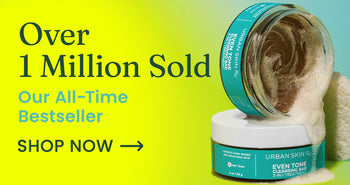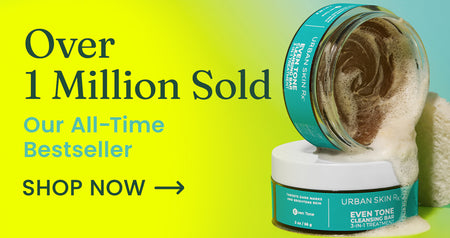What Is Exfoliation & Should It Be In Your Routine?

Facial exfoliation sounds pretty straightforward. You just exfoliate your face, and you’re done, right? Well… kinda, sorta… but there is really so much more to it than that. Did you know that there are two main types of exfoliation? Or that under each of those types, there are different methods or products that can be used? There really is a lot to know about something that seems so simple.
Keep reading if you want to know more about one of the best ways to get glowing skin!
What Is Exfoliation?
Exfoliation is the act of removing dead skin cells from the surface of your skin. You may have heard before that your skin is on a monthly cycle of shedding away the old drying skin and revealing the new, fresh skin underneath. Exfoliation can help quicken the turnover rate of your skin cells so that you see less dull, dry skin before bringing the new skin cells to the surface.
Fresh, glowing skin sooner? Yes, please!
Why We Love Exfoliating
The number one reason why we love exfoliation: glowing skin! Removing dead skin cells from the surface of your face brings on so many benefits, but by far, our favorite is seeing the beautiful, glowing skin that was buried underneath. There are so many other reasons to love it, though, including:
- Evens skin tone
- Unclogs pores
- Helps prevent breakouts
- Softens the appearance of wrinkles
- Provides a fresh, clean slate for the rest of your beauty products
With so many benefits, there’s no reason to skip this step in your beauty routine. No matter your skin type, you’ll be able to find an exfoliation method below that will work great for your skin needs.
Types of Exfoliation
There are two types of exfoliation you can use: physical and chemical. Though they are very different methods, they both do the same thing - remove dead skin cells, revealing smoother, brighter skin.
There are also many methods within each type of exfoliation, so there is definitely an option that will work great for your specific skin type and need. Read on for a breakdown of physical and chemical exfoliators.
Physical Exfoliation
Physical exfoliation is just what it sounds like - you remove the dead skin by physically rubbing something against your skin. This can be as simple as using a damp washcloth while cleansing your face.
Some people even lightly rub their face with a dry washcloth before cleansing. There are also many exfoliating mitts or sponges on the market; just make sure you find one that is gentle and meant to be use on the delicate skin of your face. Aside from using something you may already have on hand, like a washcloth, there are many other ways to physically remove build-up and reveal the glowing skin beneath it.
Microdermabrasion
Microdermabrasion is a term that you’ve probably heard before, and it falls in the physical exfoliation category.
Microdermabrasion is often performed with a mechanical tool that uses an abrasive head to buff off the dead skin from your face. Although you can buy microdermabrasion tools almost anywhere, this is something that you really want to visit a professional for.
A newer microdermabrasion method is called hydradermabrasion. Rather than using an abrasive surface to remove dead skin, hydradermabrasion uses water and serums to dislodge the cells and simultaneously vacuums the debris away.
Again, you can buy these tools for self-use, but it is advised to go to a professional instead of doing it yourself. Because hydradermabrasion tools stimulate blood flow using suction, it’s easy to bruise your skin if you aren’t careful.
Facial Scrubs
Another type of physical exfoliation is done by using a facial scrub. Facial scrubs can be creamy or thinner - more like a liquid cleanser. No matter the consistency, facial scrubs always contain an abrasive element that will buff away the dead skin from the surface of your face.
These abrasive elements can be coffee grounds, sugar, microbeads, or finely ground nutshells or pits. We can all remember our grandmother’s favorite fruit scrub from our childhood!
When choosing a facial scrub, it is very important to look for an effective but gentle one. It’s easy to overdo exfoliation with a scrub, as a lot of them can be too rough and end up causing damage to your skin. Abrasive facial scrubs can often lead to tiny, unnoticeable tears in your skin, leaving it sensitive, dry and vulnerable to UV damage. If you choose to use a facial scrub, use a very light hand. Don’t press the scrub hard onto your skin; instead, let it slide between your hands and face. Pushing hard on your skin will cause those tears we mentioned, and we want smooth skin...not torn skin.
Exfoliating Cleansers
Finally, you can knock two to-dos off your beauty routine by using an exfoliating cleanser.
Like facial scrubs, exfoliating cleansers contain a physical abrasive to help smooth away rough, dead skin, all while washing away dirt and makeup simultaneously. And also, like facial scrubs, it’s important to find the right exfoliating cleanser for your skin type. Because they contain cleansing agents, it’s even easier to go overboard and cause dryness and damage to your skin.
We have a great exfoliating cleanser here at Urban Skin Rx®. Our LacticGlow Micropolish Resurface & Brighten Cleanser is a gentle gel cleanser that contains tiny microbeads to buff away dead skin. It is also formulated with a special blend of Alpha Hydroxy Acids plus natural Jojoba Esters that reveal skin clarity by gently cleansing buildup.
Wait. Alpha Hydroxy Acids sounds a lot like a chemical, right? They are. LacticGlow uses the best of both types of exfoliation. Let’s get into the types of chemical exfoliation next.
Chemical Exfoliation
Just like physical exfoliation, chemical exfoliation is exactly what it sounds like. Chemical exfoliation is the process of using acids or fruit enzymes to remove dead skin cells from the surface of your skin. We know… this sounds a lot harsher than physical exfoliation, and it can be. But chemical exfoliation is often much less damaging and easier on sensitive skin if used correctly.
Rather than physically scrubbing off the dead outer layer of your skin, acids dissolve the bonding elements between the layers of skin, allowing the dead top layer to fall away. And because the acids can soak into the skin, it can be far more effective in clearing away rough skin than just trying to buff it away manually.
Alpha Hydroxy Acids
We’ve already mentioned Alpha Hydroxy Acids (AHAs) as an ingredient in our LacticGlow Micropolish Resurface & Brighten Cleanser. But just what is an AHA?
Alpha Hydroxy Acids are water-soluble and include:
- Lactic Acid: One of the more gentle exfoliators; derived from milk and may have been a favorite beauty secret of Cleopatra
- Glycolic Acid: Derived from sugar cane
- Citric Acids: Derived from citrus fruits
- Malic Acid: Derived from apples
Because AHAs are water-soluble, they work on the surface layer of your skin and are therefore best at treating surface issues, like discoloration or dryness.
If you’re thinking of trying an AHA, we’ve got the perfect product to get that glowing skin! BrighterDays™ Dark Spot 8% AHA Polish is another Urban Skin Rx® exfoliating product that pulls double-duty by being a scrub and containing chemical exfoliants. The polish is formulated with 5% Glycolic Acid, 3% Lactic Acid, Papaya Extract (more on this in a bit), and L-Ascorbic Acid.
Beta Hydroxy Acids
Beta Hydroxy Acids (BHAs) are oil-soluble, which means they can penetrate deeper into the skin than AHAs can. BHAs get down into pores and can unclog them, which is great for those who suffer from acne. They can also reach deep into lines and wrinkles, helping to smooth their appearance.
Some types of Beta Hydroxy Acids are:
- Salicylic Acid: Best for those with acne or enlarged pores
- Tropic Acid: Best for fine lines and wrinkles
Poly Hydroxy Acids
Poly Hydroxy Acids (PHAs) are very similar to AHAs in that they are best for surface issues. PHA molecules are larger than AHA molecules and cannot penetrate as deeply; therefore, they are best for very sensitive skin. An added benefit of PHAs is that they often draw in moisture, making them not only great for exfoliating but helpful in retaining moisture and plumping the skin, as well. Some PHAs are:
- Gluconolactone Acid
- Lactobionic Acid
Fruit enzymes are chemical exfoliants that come from… you guessed it… fruit. Much like the other acids, they break down the same bonds between the layers of the skin, resulting in a gentle shedding of dull, dead skin.
The most common enzyme products you’ll find are derived from papaya, pineapple, pomegranate, and pumpkin (there’s something about those Ps!). We mentioned our BrighterDays™ Dark Spot 8% AHA Polish previously, and it utilizes the power of papayas, while our Purifying 2-in-1 Pumpkin Pore Detox Mask & Scrub contains Bromelain, which is derived from the core of pineapples. (Did you know that instead of tossing the pineapple core, you can eat it? It’s pretty tough but still tastes great and will give you a huge dose of Bromelain from the inside out.)
Much like physical exfoliators, there are both at-home and professional options when it comes to chemical exfoliation. If using them at home, look for lower percentage concentrations, start slowly and build up to the recommended usage for that particular product. Always follow the directions on the bottle. If any irritation occurs, stop using it and let your skin rest before restarting more slowly.
Always visit your dermatologist or licensed aesthetician for a professional chemical peel if you want more dramatic results. Discuss the results you’d like to see with them, and let them recommend what will work best for your skin type. And remember, because they use stronger formulations, you may see more peeling, redness and dryness than with lower concentrations you use at home.
What Type Is Best?
The type of exfoliation that is best for you really comes down to your skin type and what results you’d like to achieve. If you’re looking for simple, practically free or very inexpensive options, using a physical exfoliator like a washcloth or gentle facial scrub may be just what you need to maintain your glowing skin.
If your skin tends to be more sensitive, a chemical exfoliator may be the better option. Gently dissolving the bonds between skin layers and naturally letting the dead skin shed away can be less irritating and abrasive to delicate skin. Just be sure to research the right type of acids and the right concentrations for your specific skin type and needs.
How Often Should I Exfoliate?
How often you exfoliate also falls back on your personal skin type and needs. Those with sensitive skin should consider exfoliating only once weekly.
This reduces the chance of stripping away the precious moisture barrier from your skin or inflicting any physical damage to it. In some cases, even once a week may be too often. Listen to your skin.
If you have oily, blemish-prone skin, or even hearty skin that doesn’t irritate easily, you can get away with exfoliating more often. If you choose to use multiple forms of exfoliation, be sure to use one at a time and break them up over a week or two. If something does end up irritating your skin, you want to know which product it was.
So, there you have it. Though facial exfoliation sounds like something relatively easy, there are so many different types and methods of getting rid of dull, dead skin and revealing the gorgeous glow that was hidden beneath the surface. If you’d like to get started on your glowing skin journey but don’t know where to start, take our Skin Quiz and book a virtual consultation to get the details on everything you need!
Engagement Manager




